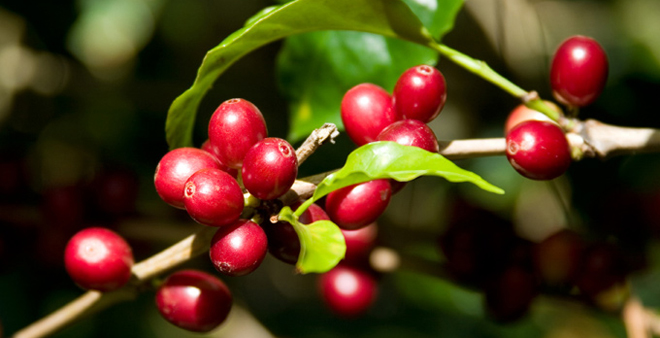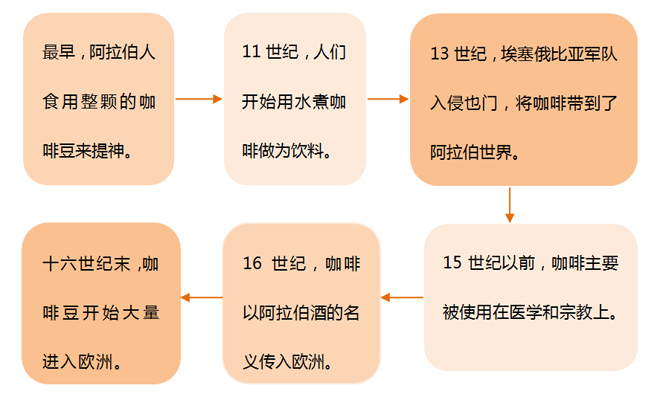The development of coffee beans and the history of the introduction of coffee beans into China
A magnificent epic of human civilization and culture for hundreds of years, coffee has been the most silent and gentle, but the most defenseless way, changing history and making history.
Legend has it that around the tenth century AD, on the Ethiopian plateau of Africa, a shepherd Carl found sheep excited after eating some kind of red fruit. As a result, Carl distributed this incredible red fruit to the locals, and its magical effect spread.
The red fruit on the coffee tree

There is also a legend that in 1258, in the mountains of Yemen, Shek Omar, who was deported by his people for crime, was exiled to Vasaba (in Arabia). When he was walking on the mountain exhausted, he found that the birds on the branches made a very sweet cry after pecking at the fruit of the tree. So he boiled the fruit with water, and after drinking it, the original feeling of tiredness was eliminated.
Later, Omar collected many of these magical fruits, and when he met someone who was sick, he made the fruit into soup for them to drink, and refreshed them. Because of his good deeds everywhere, his sins were soon forgiven. When he returned to Mocha, he was revered as a saint for finding this fruit. It is said that the magic cure at that time was coffee.
But the real evidence for the spread of coffee beans originated in Africa, as shown in the figure:

The introduction of China
Overseas Chinese in Indonesia drank coffee every day in the 1960s, and Taiwanese began to drink coffee in the 1970s. It has a history of about 40 years now. Whether Hong Kong introduced coffee earlier needs textual research. The mainland began to rise in the late 1990s. At present, many cafes have sprung up, young people have gradually accepted coffee drinks and there are a variety of places to drink coffee, including restaurants, cafes, dim sum, cake bakeries and so on.
Important Notice :
前街咖啡 FrontStreet Coffee has moved to new addredd:
FrontStreet Coffee Address: 315,Donghua East Road,GuangZhou
Tel:020 38364473
- Prev

Introduction to the manual frying method of using hand filter to roast coffee beans by hand
First, prepare 100 grams of raw coffee beans, if there are broken coffee beans, remove them. Then put the raw coffee beans in the filter, close the lid, open the gas to medium fire, hold the filter about 20-30 centimeters above the gas, swing it in a round way, and bake patiently. At first, it may not be easy, but after you get used to it, you can skillfully increase it according to your own preferences.
- Next

The taste of three-in-one instant coffee in Vietnam Coffee cultivation and extraction of Vietnamese coffee beans
Vietnamese coffee has a strong flavor, light sour taste, smooth and moist taste, slightly bitter in mellow, full-bodied, refreshing and refreshing. The representative products are moossy Coffee, Central Plains Coffee (G7 coffee), Saigon Coffee (SAGOCAFE) and Highland Coffee. The geographical location of Vietnam is very favorable for coffee cultivation. Southern Vietnam has a hot and humid tropical climate, which is suitable for growing RO.
Related
- Guji coffee producing area of Guji, Ethiopia: Humbela, Shakiso, Wulaga
- What is the most expensive variety of Qiloso in BOP multi-variety group?
- How to store the coffee beans bought home?
- Why are Yemeni coffee beans so rare now?
- Ethiopian Sidamo all Red Fruit Sun Sun Santa Vini Coffee beans
- SOE is mostly sour? What does it mean? Is it a single bean? what's the difference between it and Italian blending?
- Is Italian coffee beans suitable for making hand-brewed coffee?
- How to choose coffee beans when making cold coffee? What kind of coffee beans are suitable for making cold coffee?
- Just entered the pit to make coffee, what kind of coffee beans should be chosen?
- Can only Japan buy real Blue Mountain Coffee? What are authentic Jamaican Blue Mountain coffee beans?

